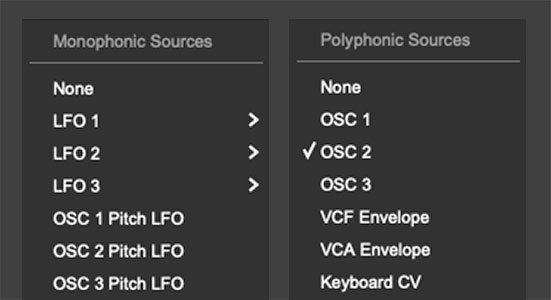Modulation Routings
Dreamsynth's modulation routings are extensive and really easy to use - there are no hidden menus, tabs, or routing grids. All mod destinations have a source popup menu button and bipolar attenuator adjacent to the parameter they affect. They're mostly a "what-you-see-is-what-you-get" affair (isn't that a Ratt tune?), but there are a few things we'll explain to make things 100% clear.
Mod Source Select button- Click to open a popup menu that selects the modulation source. If the button is dim (gray), no modulation source is currently selected. The button illuminates in green when a mod source is selected. (The attenuator still needs to be increased or decreased from its center position to apply mod.)
Mod Attenuator knob- Sets the amount of mod applied to the parameter for the currently chosen mod routing. The Mod Attenuator knobs are bipolar, so center position is off; turning the knob to the right applies positive modulation, and turning to the left applies negative modulation.
Monophonic vs. Polyphonic Mod Sources
This is important to understand, so please put on your propellerhead beanie.
Polyphonic Modulation
A simple example of a polyphonic modulation routing would be the VCF envelope modulating filter cutoff frequency (this is a "hardwired" routing - all you have to do is turn up the Filter section Env Mod knob, but the same mod routing could be set up using the Cutoff Freq mod box pop up and attenuator). If the VCF envelope controls are set for a rapidly decaying envelope, and multiple notes are played, the rapid cutoff envelope is heard individually for each note played, regardless of whether they're played simultaneously or in succession. This is referred to as "individually articulated" response, because under the hood, each note played (up to 16) has its own individual VCF envelope generator. Other examples of poly mod sources include oscillators, VCA Envelope, Keyboard CV, and Velocity.
Monophonic Modulation
Conversely, some mod sources are a single entity applied to all currently sounding voices - these are referred to as monophonic mod routings. This may seem like an inferior arrangement, but mono mod routings are actually very useful. The best example of mono mod sources are Dreamsynth's low-frequency oscillators (LFOs).
To demonstrate, we'll use another of Dreamsynth's hardwired mod routings - the humble Pitch LFO. When its Depth knob is increased, a triangle wave LFO modulates oscillator pitch for vibrato effects. If multiple notes are played, the pitch of all currently played notes changes at the same speed, depth, and phase - the phase part is the important thing. In layman's terms that means all notes rise and fall in lock step. If each voice had its own independent LFO mod, when multiple notes are played, the pitch of one might be rising while the other was falling, etc., creating a warbly, modulated mess, which (usually) isn't what you want.
(Incidentally, if you want full poly, non phase-coherent LFO mod, set Osc 3's octave range to Lo, select one of the basic Analog waves, and set the Mod Source popup menu to Osc 3. We thought of everything!)
Note that many mod sources are inherently mono by nature, for example, a mod wheel (I'm sure some wacko company makes a controller with 16 mod wheels, but we've never seen one). Other examples of mono mod sources include pitch wheels, LFOs, and the arpeggiator.
Generally speaking, some mod destinations are inherently mono (the Strings section Pitch, Pan, and Level controls, for example) and some are inherently polyphonic (all Filter sections controls, for example)

